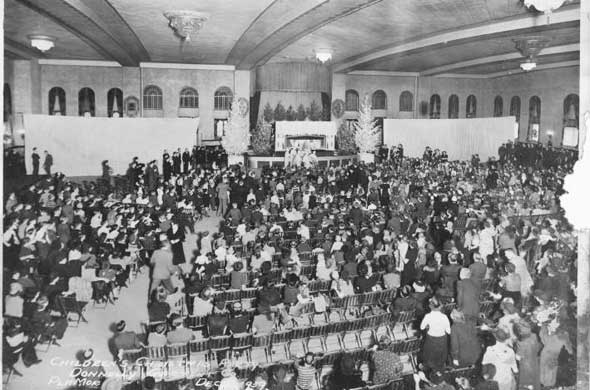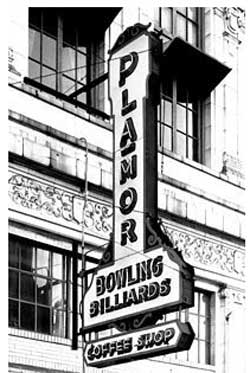
Interior view of the Pla-mor during a children’s Christmas party. Photo courtesy Missouri Valley Room, Kansas City Public Library.
By Joe Lambe
On Thanksgiving day in 1927, a huge ballroom that opened in Midtown marked a high point in the jazz age in a city known for jazz, booze and overall sin.
The Kansas City Public Library on its web site this week tells the story of the Pla-Mor Ballroom that was at 3142 Main St.
It opened Nov. 24, 1927, to thousands of people ready to dance on the wooden floor with more than 7,000 springs under it to give them that extra bounce.
The Jean Goldkette Orchestra played that night. The list of famous jazz musicians who played there for the next two decades often reads like a who’s who: Tommy and Jimmy Dorsey, Bix Beiderbecke, Frankie Trumbauer, Stan Kenton and Ella Fitzgerald are among them.
And the ballroom was just one lure to what was said to be the nation’s largest entertainment center – an amusement complex in three big buildings between Main and Wyandotte streets.
 It included a bowling alley and billiards and an ice skating rink and in 1931 added the largest swimming pool west of the Mississippi River.
It included a bowling alley and billiards and an ice skating rink and in 1931 added the largest swimming pool west of the Mississippi River.
The Pla-mor cost over $500,000 and was designed by Charles A. Smith, an architect known for work on public schools.
A blog site, kcjazzlark, gives more information on it, including a rave review from the Kansas City Times:
“Entrance was under a brilliant electric sign. Once past the door, wall decorations of freehand painting attracted attention. Rich carpet gave an impression of luxuriousness. Up a flight of steps and down a hall past the women’s cloak room the eye followed vivid hunting and jungle scenes of the modern motif. Velour tapestries were admired particularly by the women….The ball room and mezzanine were decorated in a more strictly patterned manner. Here the lighting brilliance demanded the first and lasting attention. Ceiling fixtures of beaded glass chains suspended bowl-shaped, with variable colors glowing through them, vied and tinted lamps casting full and toned colors across the floor from the walls.”
An ugly incident happened at the Pla-Mor on Dec. 22, 1945, when an off-duty policeman pistol-whipped and threw out band leader Cab Calloway because he was black.
Calloway went there to see Lionel Hampton’s band play, but while black bands could play there, blacks were not allowed in. Normally a black band leader would be allowed to see a band, but the security officer said he did not recognize Calloway before he clouted him.
Hampton was outraged, refused to play his second set and never appeared at the Pla-Mor again.
The ballroom maintained large crowds for years until it stopped operating in 1951, the library reports, and its other attractions closed years later.
From kcjazzlink:
The whole operation closed in 1957 and reopened as one of the country’s largest bowling alleys, which closed in 1966.
From 1970 to 1972, it was the rock venue Freedom Palace, where the Who once played.
The Freedom operation moved to the Cowtown Ballroom at 31st and Gillham, which was the rock hall conversion of the El Torreon Ballroom – past arch rival of the Pla-Mor.
In 1972, the Pla-Mor building on the northwest corner of Main and Linwood was demolished to make way for a car dealership.
The El Torreon building still survives at 3101 Gillham as the Cowtown Mallroom, where vendors sell vintage clothing, antiques, art and other items.



Who’s talking